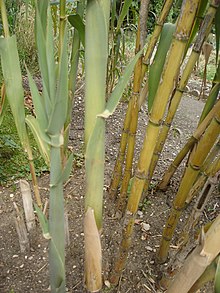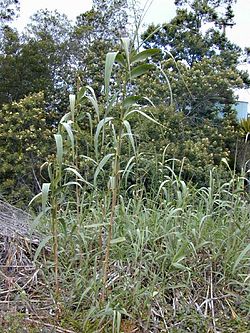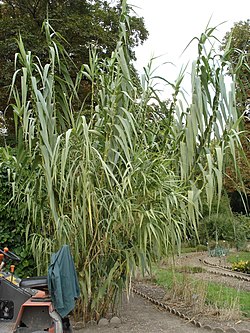Arundo donax: Difference between revisions
Jboltonnal (talk | contribs) |
|||
| Line 106: | Line 106: | ||
*[http://news21.jomc.unc.edu/index.php/stories/biofuels.html The Power in Plants: Biofuels and the Giant Cane Debate (UNC News21: Powering A Nation)] |
*[http://news21.jomc.unc.edu/index.php/stories/biofuels.html The Power in Plants: Biofuels and the Giant Cane Debate (UNC News21: Powering A Nation)] |
||
*[http://cisr.ucr.edu/giant_reed_arundo.html More info on Giant Reed from the Center for Invasive Species Research] |
*[http://cisr.ucr.edu/giant_reed_arundo.html More info on Giant Reed from the Center for Invasive Species Research] |
||
* [http://www.invasivespeciesinfo.gov/aquatics/giantreed.shtml Species Profile- Giant Reed (''Arundo donax'')], National Invasive Species Information Center, [[United States National Agricultural Library]]. Lists general information and resources for Giant Reed. |
|||
{{DEFAULTSORT:Arundo Donax}} |
{{DEFAULTSORT:Arundo Donax}} |
||
Revision as of 14:46, 16 February 2011
| Arundo donax | |
|---|---|

| |
| Giant Cane (Arundo donax) | |
| Scientific classification | |
| Kingdom: | |
| (unranked): | |
| (unranked): | |
| (unranked): | |
| Order: | |
| Family: | |
| Subfamily: | |
| Tribe: | Arundineae
|
| Genus: | |
| Species: | A. donax
|
| Binomial name | |
| Arundo donax | |
Arundo donax, Giant Cane, is a tall perennial cane growing in damp soils, either fresh or moderately saline. Other common names include Carrizo, Arundo, Spanish cane, Wild cane, and Giant reed.
Arundo donax is native to eastern and southern Asia, and probably also parts of Africa and southern Arabic Peninsula. It has been widely planted and naturalised in the mild temperate, subtropical and tropical regions of both hemispheres (Herrera & Dudley 2003), especially in the Mediterranean, California, the western Pacific and the Caribbean.[1][2] It forms dense stands on disturbed sites, sand dunes, in wetlands and riparian habitats.
Description
Arundo donax generally grows to 6 metres (20 ft), in ideal conditions it can exceed 10 metres (33 ft), with hollow stems 2 to 3 centimetres (0.79 to 1.18 in) diameter. The leaves are alternate, 30 to 60 centimetres (12 to 24 in) long and 2 to 6 centimetres (0.79 to 2.36 in) wide with a tapered tip, grey-green, and have a hairy tuft at the base. Overall, it resembles an outsize common reed (Phragmites australis) or a bamboo (Subfamily Bambusoideae).
Arundo donax flowers in late summer, bearing upright, feathery plumes 40 to 60 centimetres (16 to 24 in) long, but the seeds are rarely fertile. Instead, it mostly reproduces vegetatively, by underground rhizomes. The rhizomes are tough and fibrous and form knotty, spreading mats that penetrate deep into the soil up to 1 metre (3.3 ft) deep (Alden et al., 1998; Mackenzie, 2004). Stem and rhizome pieces less than 5 centimetres (2.0 in) long and containing a single node readily sprouted under a variety of conditions (Boose and Holt, 1999). This vegetative growth appears to be well adapted to floods, which may break up individual A. donax clumps, spreading the pieces, which may sprout and colonise further downstream (Mackenzie 2004).





Uses
Arundo donax has been cultivated throughout Asia, southern Europe, northern Africa, and the Middle East for thousands of years. Ancient Egyptians wrapped their dead in the leaves. The canes contain silica, perhaps the reason for their durability, and have been used to make fishing rods, and walking sticks.[citation needed]
The stem material is both strong and flexible. It is the principal source material for reeds for woodwind instruments such as the oboe, bassoon, clarinet, and saxophone. It is also often used for the chanter and drone reeds of many different forms of bagpipes. Giant reed has been used to make flutes for over 5,000 years. The pan pipes consist of ten or more reed pipes. Its stiff stems are also used as support for climbing plants or for vines.[citation needed]
As Arundo species grow rapidly, their use has been suggested for biomass (see below) for energy and a source of cellulose for paper; at least one North American paper mill was considering planting it for a source of pulp fibre (Samoa Pacific, on Humboldt Bay, California, in 2002), but abandoned the plan by early 2003.[citation needed]
Biofuel and carbon sequestration
Arundo donax is strong candidate for use as a renewable biofuel source because of its fast growth rate, ability to grow in different soil types and climatic conditions. A. donax will produce an average of three kilograms of biomass per square metre (25 tons per acre) once established [3]. The energy density of the biomass produced is 17 MJ/Kg regardless of fertilizer usage [3].
Studies in the European Union have identified A. donax as the most productive and lowest impact of all energy biomass crops (see FAIR REPORT E.U. 2004).
Arundo donax's ability to grow for 20 to 25 years without replanting is also significant. In addition to being a biomass source, A. donax is also known to release volatile organic compounds (VOCs), mainly isoprene [4].
In addition to providing superior biomass yields with low environmental impact as a most viable source or energy biomass, A. donax also provides some of the most significant below ground carbon sequestration in addition to its above ground up-take due to its rapid growth. Arundo donax can thus provide a superior renewable energy biomass source with added environmental benefits.[citation needed]
In the UK it is considered suitable for planting in and around water areas [5]
Chemicals
Studies have found this plant to be rich in active tryptamine compounds, but there are more indications of the plants in India having these compounds than in the United States.[6] Toxins such as bufotenidine[7] and gramine[6] have also been found.
The dried rhizome with the stem removed has been found to contain 0.0057% DMT, 0.026% bufotenine, 0.0023% 5-MeO-MMT.[6] The flowers are also known to have DMT and the 5-methoxylated N-demethylated analogue, also 5-MeO-NMT. The quite toxic quaternary methylated salt of DMT, bufotenidine,[6] has been found in the flowers, and the cyclic dehydrobufotenidine has been found in the roots.[citation needed]
Ethnobotany
This plant may have been used in combination with Harmal (Peganum harmala) to create a brew similar to the South American ayahuasca, and may trace its roots to the Soma of lore.[8]
Invasive species
Arundo donax was introduced from the Mediterranean to California in the 1820s for roofing material and erosion control in drainage canals in the Los Angeles area (Bell 1997; Mackenzie 2004). Through spread and subsequent plantings as an ornamental plant, and for use as reeds in woodwind instruments, it has become naturalised throughout warm coastal freshwaters of North America, and its range continues to spread.
It has been planted widely through South America and Australasia (Boose and Holt 1999; Bell 1997) and in New Zealand it is listed under the National Pest Plant Accord as an "unwanted organism".[9]
It is among the fastest growing terrestrial plants in the world (nearly 10 cm/ day; Dudley, 2000). To present knowledge Arundo does not provide any food sources or nesting habitats for wildlife. This results in resources provided by the crowded-out native plants not being replaced by the Arundo (Bell 1997; Mackenzie 2004). For example, it damages California's riparian ecosystems by outcompeting native species, such as willows, for water. A. donax stems and leaves contain a variety of harmful chemicals, including silica and various alkaloids, which protect it from most insect herbivores and deter wildlife from feeding on it (Bell 1997; Miles et al. 1993; Mackenzie 2004). Grazing animals such as cattle, sheep, and goats may have some effect on it, but are unlikely to be useful in keeping it under control (Dudley 2000).
Arundo donax appears to be highly adapted to fires, which are unusual in native Californian riparian habitats. It is highly flammable throughout the year, and during the drier months of the year (July to October), it can increase the probability, intensity, and spread of wildfires through the riparian environment, changing the communities from flood-defined to fire-defined communities. After fires, A. donax rhizomes can resprout quickly, outgrowing native plants, which can result in large stands of A. donax along riparian corridors (Bell 1997; Scott 1994). Fire events thus push the system further toward mono-specific stands of A. donax.
The experience of a leading energy grass research expert[who?] at a well renowned Southeastern United States University[where?] with test plots of A. donax have provided significantly different results and conclusions as to the potential susceptibility of A. donax to significant fires. The tests show that at least in the Southeastern United States A. donax is not at all susceptible to burning and proves to be difficult to burn while standing in the field, even when dormant in the winter.
A waterside plant community dominated by A. donax may also have reduced canopy shading of the in-stream habitat, which may result in increased water temperatures. This may lead to decreased oxygen concentrations and lower diversity of aquatic animals (Bell 1997).
This article contains instructions, advice, or how-to content. (September 2009) |
Control Measures
As the impact of the Arundo donax increased in the environment and native species various efforts have been taken to reduce its population. It has no natural enemy in alien countries and inability to use as a cattle feed due to its poisonous nature made it a tough call. As a biological control herbivores insects has been imported form Mediterranean Europe (Bell, 1997; Miles et al. 1993; Mackenzie 2004, Goolsby 2007), namely Arundo wasp, Tetramesa romana; the Arundo scale, Rhizaspidiotus donacis; and the Arundo fly, Cryptonevra has known to have some effect in damaging the plant. Tetramesa romana and more recently Rhizaspidiotus donacisis were registered in the US as biological control agents.
Other remedies like using mechanical force also been employed since Arundo donax doesn’t reproduce by seeds destroying its root structure can be effective also preventing it getting sunlight will deplete the plant (Mackenzie 2004). Systemic herbicides and Glyphosate were also used as chemical remedies.
When improperly planted in riparian areas with fast moving flood waters, which has been the experience in California and Texas, there is evidence the A. donax can be carried downstream to establish new colonies. However, There is no evidence of invasiveness when properly planted and managed in non-riparian areas. Additionally, there is no documented evidence of any such 'colonization' by Arundo donax anywhere in the Southeastern United States where A. donax has been present in some cases for over 200 years.
References
Notes
- ^ "Catalogue of Life 2008".
- ^ http://ucce.ucdavis.edu/datastore/detailreport.cfm?usernumber=8&surveynumber=182 University of California website, Agriculture and Natural Resources
- ^ a b Angelini, L.G., Ceccarinia, L., and Bonarib E.; European Journal of Agronomy, 22, 2005, pp 375-389
- ^ Owen, S.M., Boissard, C., and Hewitt, C. N. Atmospheric Environment, 35, 2001, pp 5393–5409
- ^ BS 7370-5 Recommendations for maintenance of water areas
- ^ a b c d Erowid Arundo Donax Info Page 1
- ^ Erowid Arundo Donax Info Page 3
- ^ S. Ghosal, S. K. Dutta, A. K. Sanyal, and Bhattacharya, "Arundo donex L. (Graminae), Phytochemical and Pharmacological Evaluation," in the Journal of Medical Chemistry, vol. 12 (1969), p. 480.]
- ^ "Giant reed". Biosecurity New Zealand. Retrieved 2009-01-13.
General References
- Alden, P., F. Heath, A. Leventer, R. Keen, W. B. Zomfler, eds. 1998. National Audubon Society Field Guide to California. Knopf, New York.
- Bell, G. P. 1997. Ecology and Management of Arundo donax, and approaches to riparian habitat restoration in southern California. In Plant Invasions: Studies from North America and Europe, eds. J. H. Brock, M. Wade, P. Pysêk, and D. Green. pp. 103–113. Backhuys, Leiden, the Netherlands.
- Boose, A. B., and J. S. Holt. 1999. Environmental effects on asexual reproduction in Arundo donax. Weeds Research 39: 117-127.
- Dudley, T. L. 2000. Noxious wildland weeds of California: Arundo donax. In: Invasive plants of California's wildlands. C. Bossard, J. Randall, & M. Hoshovsky (eds.).
- Herrera, A., and T. L. Dudley. 2003. Invertebrate community reduction in response to Arundo donax invasion at Sonoma Creek. Biol.Invas 5:167-177.
- Mackenzie, A. 2004. Giant Reed. In: The Weed Workers' Handbook. C. Harrington and A. Hayes (eds.) www.cal-ipc.org/file_library/19646.pdf
- Miles, D. H., K. Tunsuwan, V. Chittawong, U. Kokpol, M. I. Choudhary, and J. Clardy. 1993. Boll weevil antifeedants from Arundo donax. Phytochemistry 34: 1277-1279.
- Perdue, R. E. 1958. Arundo donax – source of musical reeds and industrial cellulose. Economic Botany 12: 368-404.
- Scott, G. 1994. Fire threat from Arundo donax. pp. 17–18 in: November 1993 Arundo donax workshop proceedings, Jackson, N.E. P. Frandsen, S. Douthit (eds.). Ontario, CA.
- Tu, M., C. Hurd, and J. M. Randall. 2001. Weed Control Methods Handbook: Tools and Techniques for Use in Natural Areas. The Nature Conservancy.
- Excerpted from Chapter 15 of TIHKAL, 1997
External links
- Project on influence of Arundo donax in California
- Arundo as an invasive species in California
- The Nature Conservancy: Arundo donax Info
- The Nature Conservancy Weed Control Methods Handbook
- Images of Arundo Donax
- Arundo donax (Plants for a Future Databases)
- Arundo donax Info (USDA Forest Service)
- The Power in Plants: Biofuels and the Giant Cane Debate (UNC News21: Powering A Nation)
- More info on Giant Reed from the Center for Invasive Species Research
- Species Profile- Giant Reed (Arundo donax), National Invasive Species Information Center, United States National Agricultural Library. Lists general information and resources for Giant Reed.
- Articles needing cleanup from September 2009
- Arundinoideae
- Flora of Asia
- Flora of Africa
- Energy crops
- Invasive plant species
- Invasive plant species in the United States
- Invasive plant species in California
- Invasive plant species in Arizona
- Invasive plant species in Nevada
- Invasive plant species in Utah
- Invasive plant species in New Mexico
- Invasive plant species in New Zealand
